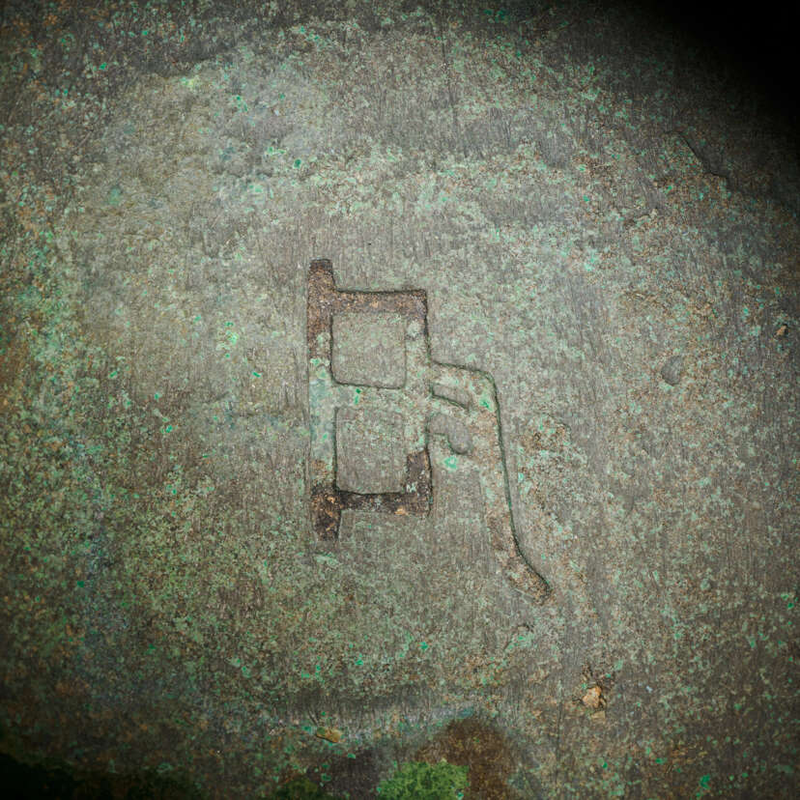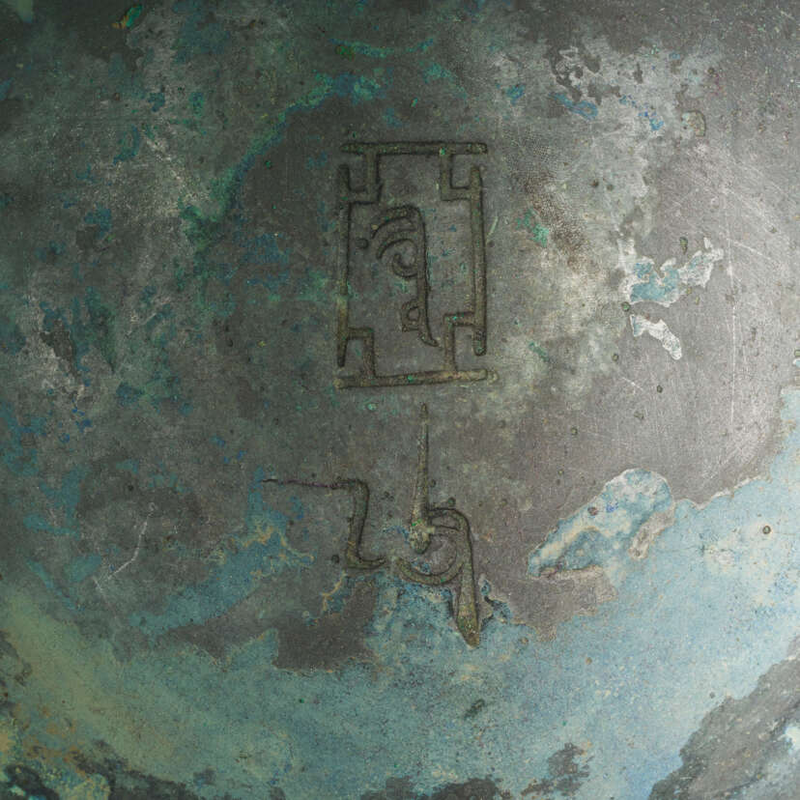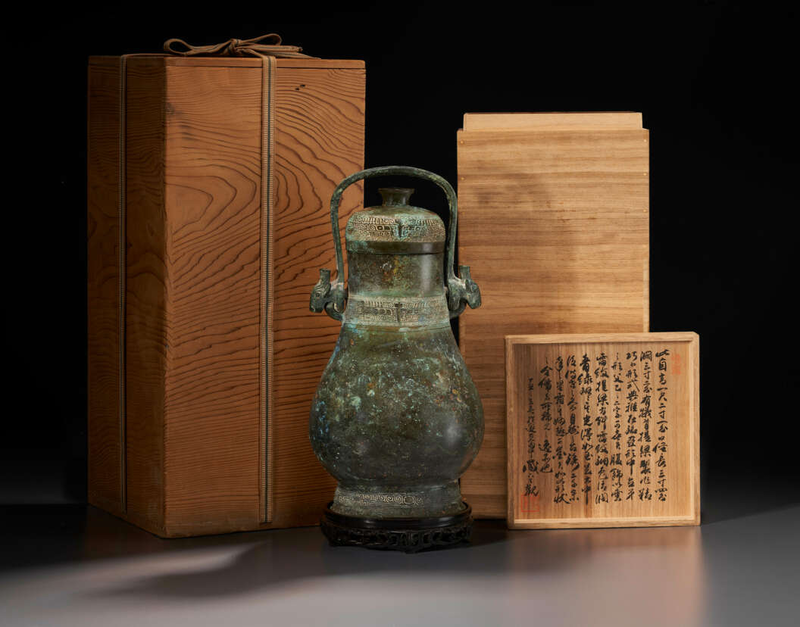Bronzes from Mineo Hata Collection at Christie's New York, 21 september 2023
Lot 851. A rare small bronze ritual wine vessel and cover, you, Early Western Zhou dynasty, 11th-10th century BC; 21 cm high, Japanese wood box. Estimate USD 100,000 – USD 150,000. © Christie's Image Ltd 2023
The vessel is cast with a band of vertical narrow ribs between bands of birds reserved on leiwen around the neck and foot, below a similar band cast on the sides of the cover. The interior of the vessel is cast with a single graph, qi.
Provenance : Sadazo Ota Collection, Kyoto, in Japan prior to 1959.
Mineo Hata Collection, Kobe, Japan.
Literature: Sueji Umehara, Nihon shucho shina kodo seika (Selected Relics of Ancient Chinese Bronzes from Collections in Japan), vol. 1, Osaka, 1959, no. 69.
Note: The graph cast on the interior of the vessel, qi (possibly a clan sign) can be found on other late Shang and early Western Zhou bronze vessels, such as a bronze jue and a bronze gu excavated from Xiaqiyuan village, Ci county, Hebei province in 1966, illustrated in Wenwu 1974, vol. 11, pp. 93-94, figs. 12 and 25; and a bronze zun in the Avery Brundage Collection, Asian Art Museum of San Francisco, no. B60B1022.
A very similar you, and possibly the current you, is illustrated by Minao Hayashi in In Shu Jidai Seidoki no Kenkyu (Conspectus of Yin and Zhou bronzes), Tokyo, 1986, vol. I, p. 262, no. 61.
Lot 852. A bronze ritual wine vessel and cover, you, Early Western Zhou dynasty, 11th-10th century BC; 36.5 cm high, zitan stand, Japanese double wood box inscribed by Hata Zoroku I (1823-1890) or Hata Zoroku IV (1898 -1984). Estimate USD 200,000 – USD 300,000. © Christie's Image Ltd 2023
The pear-shaped vessel is cast on the neck and the domed cover with a narrow band of kui dragons confronted on narrow flanges, and raised on a splayed foot encircled by a band of four 'eyes' centering diagonally-arranged scrolls. The arc-shaped handle is decorated with dense lozenge patterns and terminates on each end with an animal-head with bottle horns. The interior of the vessel and the interior of the cover are cast with matching four-character inscriptions reading ya mao fu yi (Ya X. Father Yi).
Provenance: In Japan prior to 1939.
Mineo Hata Collection, Kobe, Japan.
Literature: Osaka Municipal Museum, Grand Exhibition of Chinese Art, Osaka, 1939, cat. no. 18.
Minao Hayashi, In Shu Jidai Seidoki no Kenkyu (Conspectus of Yin and Zhou bronzes), Tokyo, 1986, vol. 1, p. 263, no. 66.
Exhibited: Osaka, Osaka Municipal Museum, Grand Exhibition of Chinese Art, 22 April-14 May 1939.
Note: A bronze you of similar size, shape, and decoration, but lacking the animal-head terminals, is illustrated by Jessica Rawson in Western Zhou Ritual Bronzes from the Arthur M. Sackler Collections, Cambridge, Massachusetts, vol. IIB, pp. 482-83, no. 65. Also illustrated, pp. 478-79, no. 64, is another bronze you of similar shape and size, but with narrow bands of dragons rather than taotie, which was subsequently sold at Christie's New York, 20 September 2013.
Lot 853. A very rare large bronze ritual wine vessel, jue, Late Shang dynasty, 13th-11th century BC; 26.7 cm high, jade-inset hardwood stand with a circular seal reading Huaimi Shanfang, Japanese double wood box. Estimate USD 200,000 – USD 300,000. © Christie's Image Ltd 2023
The body is cast with a wide band comprising two taotie masks on a leiwen ground below a band of small triangular blades. A two-character inscription, zi bu, is cast beneath the handle, which is surmounted by a bovine mask.
Provenance: Cao Zaikui (Qiufang, 1782-1852) Collection.
Pan Jiyu (Zengwei, 1818-1886) Collection.
Masuda Takashi (1848-1938) Collection.
Mitsui Sumitomo Family, The Beiquan Ge Collection.
Mineo Hata Collection, Kobe, Japan.
Literature: Cao Zaikui, Huaimi Shanfang Jijin tu (The Records of Auspicious Bronzes in the Huaimi Shanfang Studio), 1839, vol. 1, p. 16.
Wu Shifen, Jungulu jinwen (Collection of Ancient Bronze Inscriptions), 1895, vol. 1, p. 34.
Wu Dacheng, Kezhai jigulu (Bronze Inscriptions at the Kezhai Studio), 1918, vol. 21, p. 13, no. 1.
Liu Tizhi, Xiaojiaojingge jinwen taben (Rubbings of Archaic Bronze Inscriptions at the Xiaojiaojingge Studio), 1935, vol. 6, p. 29, no. 5.
Wang Chen, Xu Yinwencun (Continuation of the Surviving Writings from the Yin Dynasty), 1935, vol. 2, p. 15, no. 12.
Luo Zhenyu, Sandai jijin wencun (Surviving Writings from the Xia, Shang, and Zhou Dynasties), 1937, vol. 15, p. 31.
Yan Yiping, Jinwen zongji (Corpus of Bronze Inscriptions), Taipei, 1983, p. 2102, no. 3562.
Zhongguo shehui kexueyuan kaogu yanjiusuo (Institute of Archaeology, Chinese Academy of Social Sciences), ed., Yinzhou jinwen jicheng (Compendium of Yin and Zhou Bronze Inscriptions), Beijing, 1993, vol. 13, p. 233, no. 8110.
Yan Zhibin, Shilun Shangdai qingtongqi mingwen zhong suo fanying de gongtong zuoqi xianxiang (A Study on the Phenomenon of Cooperative Work Reflected in the Inscriptions of Shang Dynasty Bronze Artifacts), Message of the Research Center for Ancient Civilizations of CASS, vol. 14, 2007, pp. 23-33 (not illustrated).
Wu Zhenfeng, Shang Zhou qingtongqi mingwen ji tuxiang jicheng (A Collection of Inscriptions and Images of Shang and Zhou Archaic Bronzes), Shanghai, 2012, vol. 15, p. 206, no. 7366.
Note: This impressively large bronze jue was formerly in the collections of Cao Zaikui (Qiufang, 1782-1852) and Pan Jiyu (Zengwei, 1818-1886). Cao Zaikui was a native of Suzhou, Jiangsu province, and renowned as a collector and researcher of ancient Chinese bronze vessels. The present jue is recorded in his seminal 1839 publication Huaimi Shanfang Jijin Tu (The Records of Auspicious Bronzes in the Huaimi Shanfang Studio). Cao's hall name, Huaimi Shanfang, is inscribed on the underside of the jade-embellished hardwood stand accompanying the current jue. Pan Jiyu, also a native of Suzhou, was a literatus who wrote a number of poems and essays. He was the fourth son of Pan Shi'en (1769-1854), who was the Grand Minister of State, Grand Secretary of the Hall of Military Glory, and Grand Mentor, and served during the reigns of four Qing emperors: Qianlong, Jiaqing, Daoguang, and Xianfeng. Pan Jiyu's nephew, Pan Zuyin (1830-1890), was also a high-ranking official, as well as a famous collector who amassed a collection of more than 500 bronze vessels in the late Qing dynasty. Masuda Takashi (1848-1938) was an important collector and a Japanese tea ceremony practitioner in the late 19th and early 20th century, and served as a senior manager for Mitsui & Co.
The inscription cast under the handle of the present jue, zi bu, is rare to find on extant Shang bronze vessels, but is recorded on oracle bones. Some scholars, such as Hu Houxuan, suggest zi bu may represent the name of one of the many sons of the Shang king, Wu Ding. See Hu Houxuan, “Yindai hunyin jiating zongfa shengyu zhidu kao (Study of the marriage, family, kinship, and reproductive systems of the Shang dynasty)”, in Jiaguxue Shangshi Luncong Chuji, Shijiazhuang, 2002, pp. 98-100). However, in his discussion of the current jue in “Shilun shangdai qingtongqi mingwen zhong suo fanying de gongtong zuoqi xianxiang (Discussion on the phenomenon of collaborative sponsorship reflected in the inscriptions on the bronze vessels of the Shang dynasty)”, Message of the Research Center for Ancient Civilizations of CASS, vol. 14, 2007, pp. 23-33, Yan Zhibin notes that because the present jue shows stylistic features of Phase IV of Yinxu rather than Phase II of the Wu Ding era, zi bu should be interpreted as a clan sign.
A bronze jue with similar decoration, but of larger size (33.7 cm.), in the Alfred F. Pillsbury Collection in the Minneapolis Institute of Art, is illustrated by Bernhard Karlgren in A Catalogue of the Chinese Bronzes in the Alfred F. Pillsbury Collection, Minneapolis, 1952, pp. 41-42, pl. 17, no. 13.
Lot 854. A small ritual bronze wine vessel, zhi, Late Shang-Early Western Zhou dynasty, 11th century BC; 14 cm high, hardwood stand, Japanese double wood box. Estimate USD 18,000 – USD 25,000. © Christie's Image Ltd 2023
The pear-shaped vessel is cast with a narrow band of leiwen and a pair of thin bow-string bands on the tall foot. The interior is cast with a six-character inscription, zi zuo fu yi bao yi (son made this precious vessel for Father Yi), and the base is cast with a cicada.
Provenance: In Japan prior to the 1970s.
Mineo Hata Collection, Kobe, Japan.
Note: The inscription cast on the interior of the current zhi can be found on a bronze gui illustrated by Yan Yiping, Jinwen zongji, Taipei, 1983, p. 1130, no. 2157. Also illustrated, p. 3564, no. 6559, is a zhi of similar size to the present vessel cast with a similar band of leiwen and thin bow-string bands on the tall foot.
Lot 855. A large bronze circular 'lion and grapevine' mirror, Tang dynasty (AD 618-907); 22.3 cm diam., Japanese fitted wood box inscribed by Hata Zoroku II (1861-1936). Estimate USD 15,000 – USD 18,000. © Christie's Image Ltd 2023
One side is crisply cast in relief with a central lion-form knob surrounded by three writhing beasts interspersed with three winged horses amidst a fruit-laden grapevine. The outer band depicts various animals including lions, birds and horses amidst further fruiting grapevine, below a narrow border of clouds on the raised rim. The reverse is plain.
Provenance: In Japan by 1936.
Mineo Hata Collection, Kobe, Japan.
Lot 856. A very rare gold and glass-inlaid bronze tiger-head-form fitting, Late Eastern Zhou period, 4th-3rd century BC; 5.1 cm long, metal stand, Japanese wood box. Estimate USD 30,000 - USD 50,000. © Christie's Image Ltd 2023
The fitting is powerfully cast in the form of a tiger head with jaws open in a roar below the eyes inset with turquoise-colored glass. The neck is pierced on either side for attachment.
Provenance: In Japan prior to 1991.
Mineo Hata Collection, Kobe, Japan.
Literature: Osaka Municipal Museum of Fine Art, Chugoku sengoku jidai no bijutsu (The Art of the Warring States Period), Osaka, 1991, p. 127, no. 213.
Exhibited: Osaka, Osaka Municipal Museum of Fine Art, Chugoku sengoku jidai no bijutsu (The Art of the Warring States Period), 8-20 October 1991.
Note: This fitting exhibits the outstanding quality of inlaid fittings from this period. A nearly identical gold-inlaid bronze fitting, but lacking inlaid eyes, is illustrated in the Eskenazi exhibition catalogue, Inlaid Bronze and Related Material from Pre-Tang China, London, 1991, pp. 66-7, no. 21. Another similar example, but shown with jaws closed, was excavated from Linzi district, Zibo city, Shandong province, illustrated in “Xi Han Qi Wang Mu Suizang Qiwu Keng” (The Funerary Pits Round the Princely Tombs of Qi Kingdom of the Western Han Dynasty), Kaogu Xuebao, 1985, vol. 2, p. 249, fig. 3. A related silver-inlaid bronze tiger head-form fitting, dated to the late Eastern Zhou period, 3rd century BC, is illustrated by J. Fontein and Tung Wu in Unearthing China's Past, Boston, 1973, p. 56, no. 16.
Christie's. Mineo Hata: An Instinctive Eye, New York, 21 september 2023

/https%3A%2F%2Fprofilepics.canalblog.com%2Fprofilepics%2F1%2F0%2F100183.jpg)
/https%3A%2F%2Fstorage.canalblog.com%2F03%2F02%2F119589%2F96711876_o.jpg)
/https%3A%2F%2Fstorage.canalblog.com%2F11%2F31%2F119589%2F94773502_o.jpg)
/https%3A%2F%2Fstorage.canalblog.com%2F20%2F83%2F119589%2F94772815_o.jpg)
/https%3A%2F%2Fstorage.canalblog.com%2F26%2F72%2F119589%2F75604929_o.jpg)
/https%3A%2F%2Fstorage.canalblog.com%2F59%2F60%2F119589%2F26458628_o.jpg)

































/http%3A%2F%2Fstorage.canalblog.com%2F25%2F26%2F119589%2F129172198_o.jpg)
/http%3A%2F%2Fstorage.canalblog.com%2F42%2F38%2F119589%2F128993860_o.jpg)
/http%3A%2F%2Fstorage.canalblog.com%2F45%2F23%2F119589%2F127219593_o.jpg)
/http%3A%2F%2Fstorage.canalblog.com%2F27%2F01%2F119589%2F121530909_o.jpg)